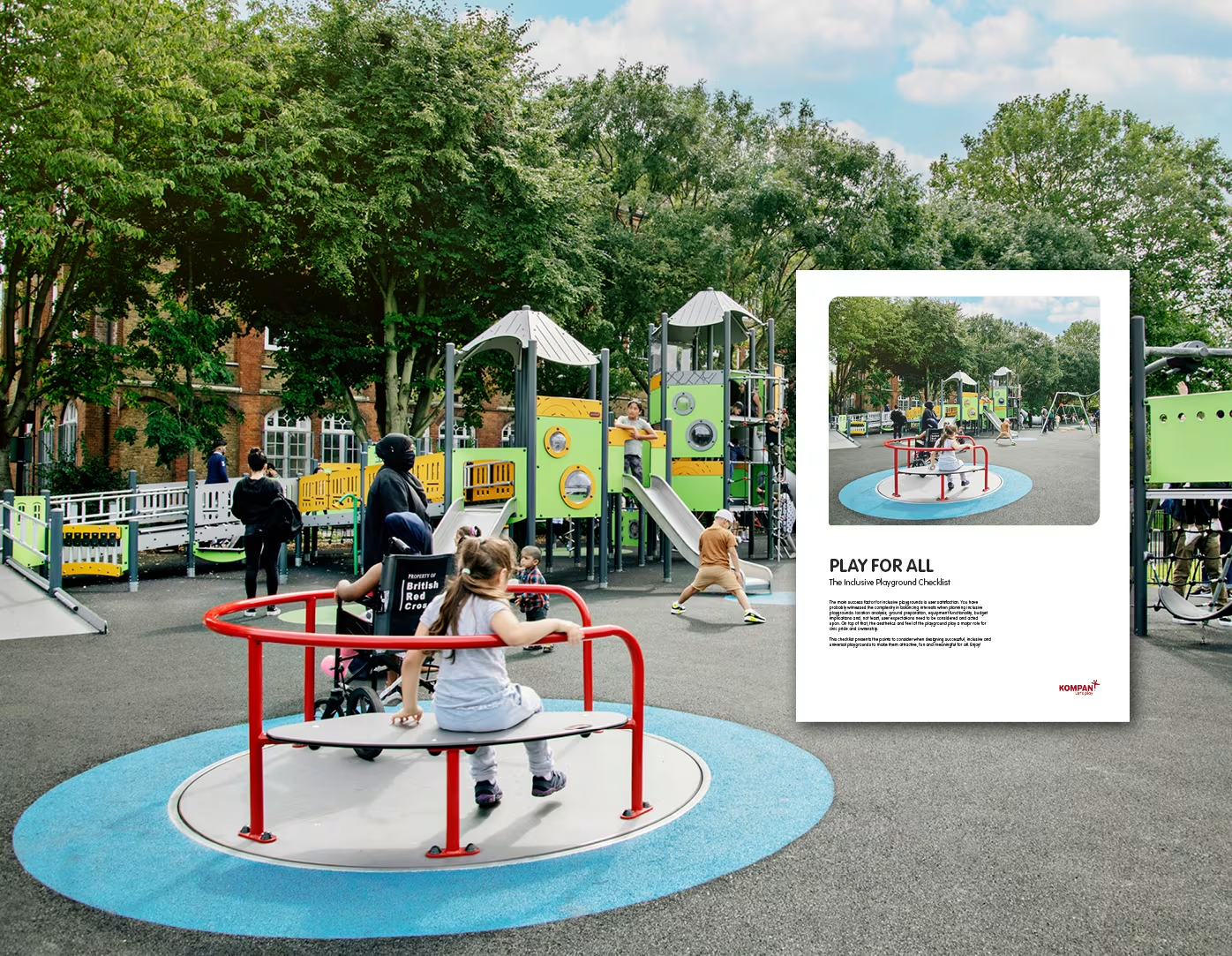kompan play institute
What does Inclusive Play mean?

Communal play areas offer a prime opportunity for fostering social cohesion and promoting inclusivity. As these public spaces are intended for all citizens, urban planners must ensure equitable access and usability for everyone.
What is an inclusive playground?
Inclusion accentuates what individuals of all abilities can contribute rather than what they cannot do: the environment is disabling, not the people, if access is not feasible. People of all abilities should be able to access, be included, and be invited to engage in public playgrounds.
A truly inclusive playground accommodates both invisible and visible disabilities, and adheres to the universal design principles:
Equitable use
Flexibility in use
Simple and intuitive to use
Perceptible information
Tolerance for error
Low physical effort
Size and space for approach and use
In a playground context, Principle 6, low physical effort, is less relevant. A high physical thrill level often involves physical exertion and is one of the very motivations of great playgrounds. The universal design principles were developed in the 1990s by design practitioners*. The principles have become widely recognised as a way of working with facilities that everyone can use to the greatest possible extent.
* Seven Principles of Universal Design (Ron Mace et al, 1997)
Benefits of inclusive playgrounds

The increased awareness and sensitivity to neurodiversity diagnoses, such as attention deficit hyperactivity disorder (ADHD), attention deficit disorder (ADD) or autism spectrum disorder (ASD), calls for additional measures to be considered.

1. Get Around
Inclusive playgrounds necessitate accessible pathways and safe surfacing. Ample space for carers to navigate to play areas is crucial, along with safety surfacing suitable for all, including wheelchair users. A well-designed inclusive playground adheres to the principle that while not all users can engage in every activity, they should be offered as many opportunities as possible to play and interact.

2. Stay
An inclusive design emphasises retention and prolonged visits, which requires considering users' need for variety, diverse play areas, and break points. If these break points are relatively close to the playground, children won't worry that the break signals the end of playtime. Ample benches strategically placed near the play zones allow users with mobility issues, whether young or old, to enjoy extended stays at the playground.
3. Play
Diversity in play experiences is crucial for a successful inclusive playground. Thrilling activities should never lack excitement or engagement, as thrill is a key factor for all children, regardless of abilities. However, should cater to more than just the daring souls. Acknowledging the desire for social play among small and large groups of children, as well as the need for individual play, such as at play panels or on single-use active play structures, is essential.
Your exhaustive guide
Universally Inclusive Playgrounds
Here’s a preview of this exclusive publication:
An exploration of top design principles for creating inclusive playgrounds
A comprehensive checklist to perfect your inclusive design
Inspirational examples of inclusive playgrounds from around the globe
Our top recommendations for inclusive playground products
Download your magazine below ↓
Ensuring invisible inclusion for all
The three design principles should cover not only visible disabilities, but also neurodivergent conditions.
Accessibility as a neurodiversity-friendly feature involves helping with navigation in the playground. Maps, signs, and play area guidance will assist many users, especially those who struggle with processing multiple sensory inputs at the same time, including people with AD(H)D or ASD. Clear maps for finding your way at the entrance and seating provisions at the entrance will be helpful. Recognisable markers for routes to quieter and more natural play areas, as well as rest zones, are advantageous.
When designing neurodiversity-friendly playgrounds, the boundaries of functionality should be marked. Using color and texture contrasts around play zones and signaling transitions between different types of play activities will help guide users. Responsive play elements, such as swings, rotating equipment, or slides, can be outlined with contrasting color dots on the surfacing beneath them to assist users. For users with visual impairments, the textures on the ground and contrasting colors around play zones can aid in navigation and functionality indications; for example, explanatory signs that facilitate communication will benefit many.
Research from the KOMPAN Play Institute
Since the 1990s, KOMPAN Play Institute has been actively involving kids of all ages and abilities in the research and development process, ensuring their voices are heard.
The KOMPAN Play Institute is a dedicated unit within KOMPAN, comprising play specialists who conduct research, develop innovative solutions, and document emerging trends in children's and families' play experiences in playgrounds. This institute plays a crucial role in KOMPAN's child-centric approach to play, with trained scholars and researchers utilising certified course materials.
Promoting Equitable Access to Playgrounds
Equity is a United Nations' Sustainable Development Goal, essential for creating happier, healthier, and more sustainable communities. However, not everyone has equal access to leisure facilities and playgrounds. Children with disabilities participate significantly less in active play and physical activities compared to their peers. Since active play is a major contributor to child health, ensuring accessibility and usability of public playgrounds for children of all abilities is crucial for their physical and social-emotional well-being and overall health.
Newsletter sign up
Fill in the boxes, and you are all set.







